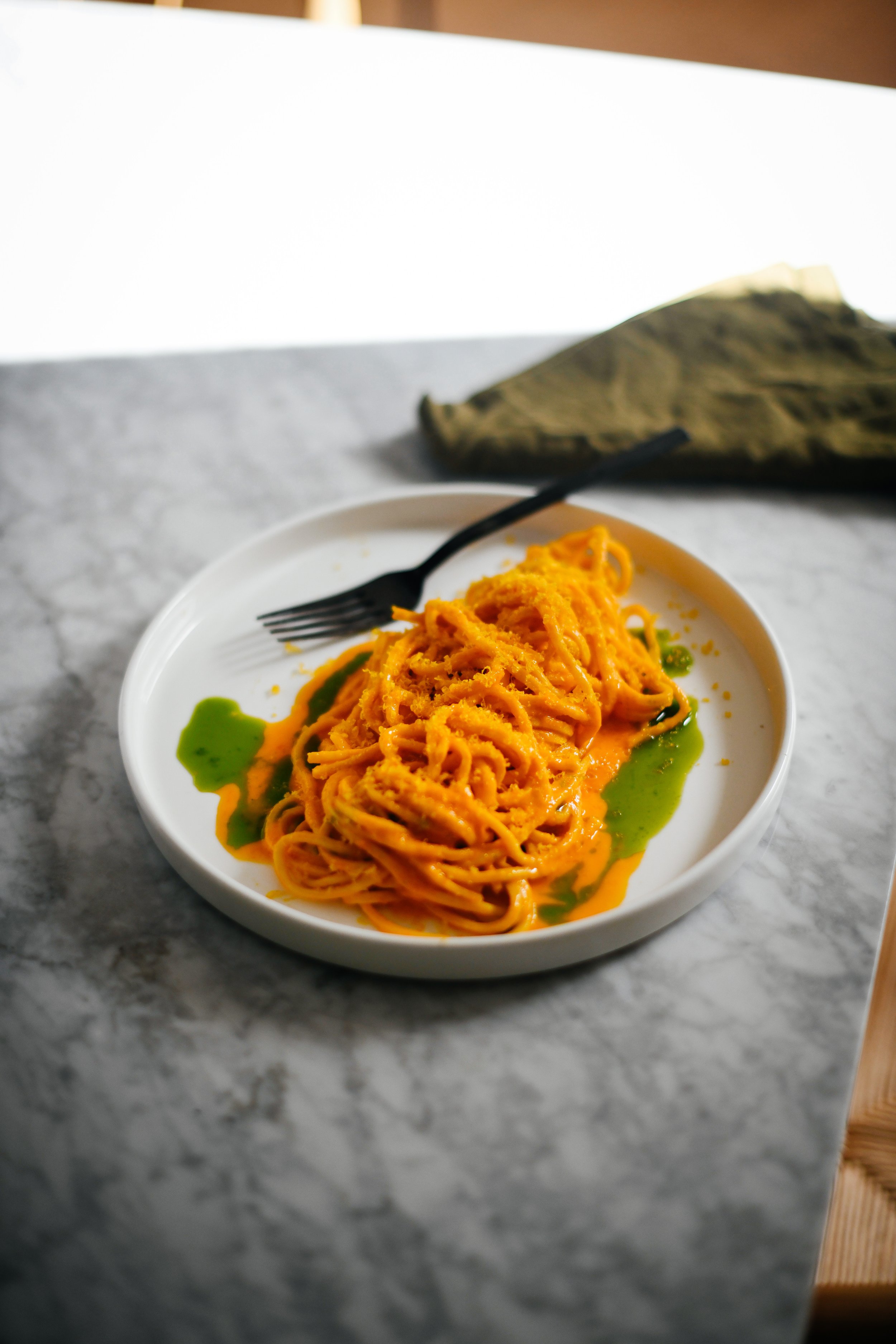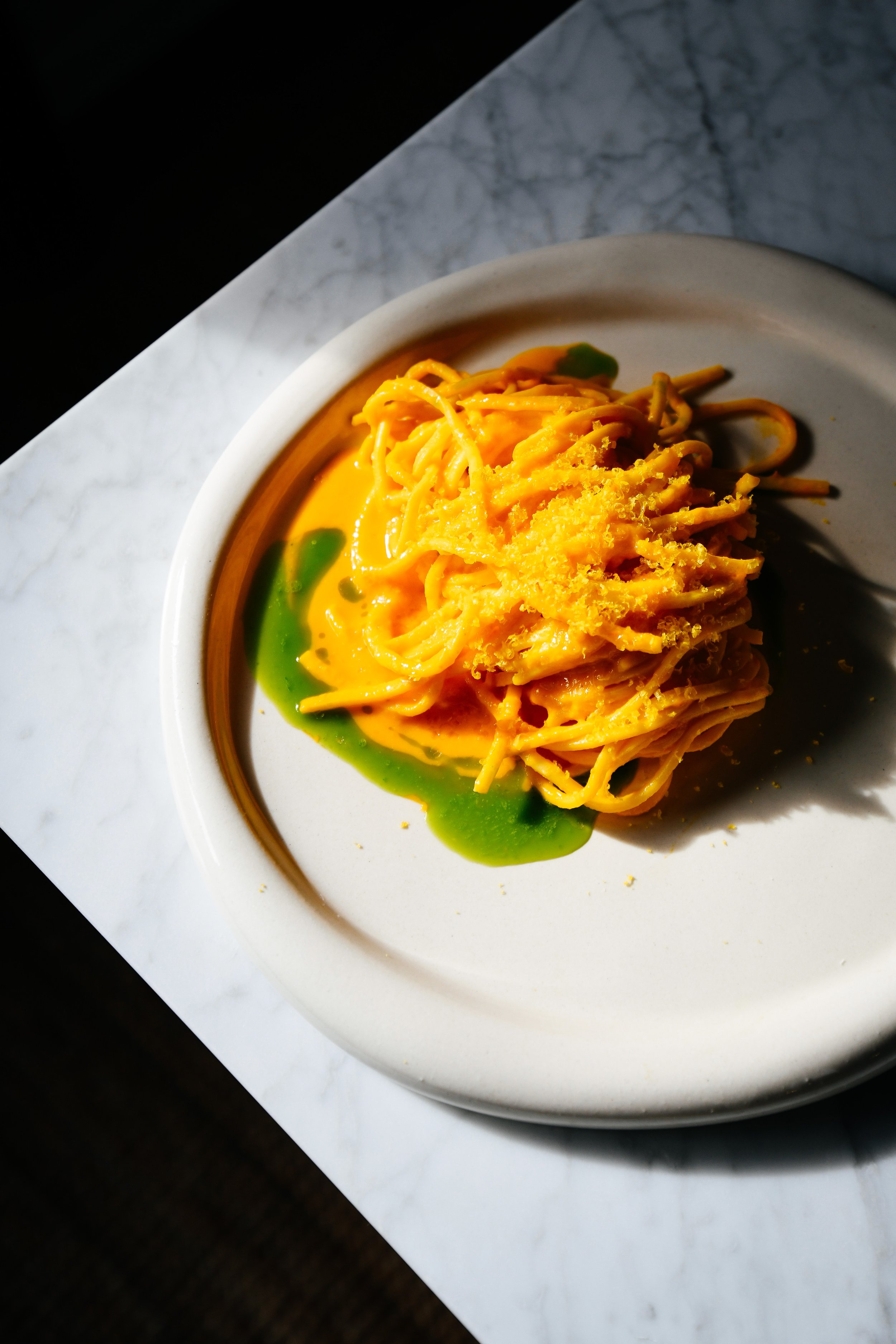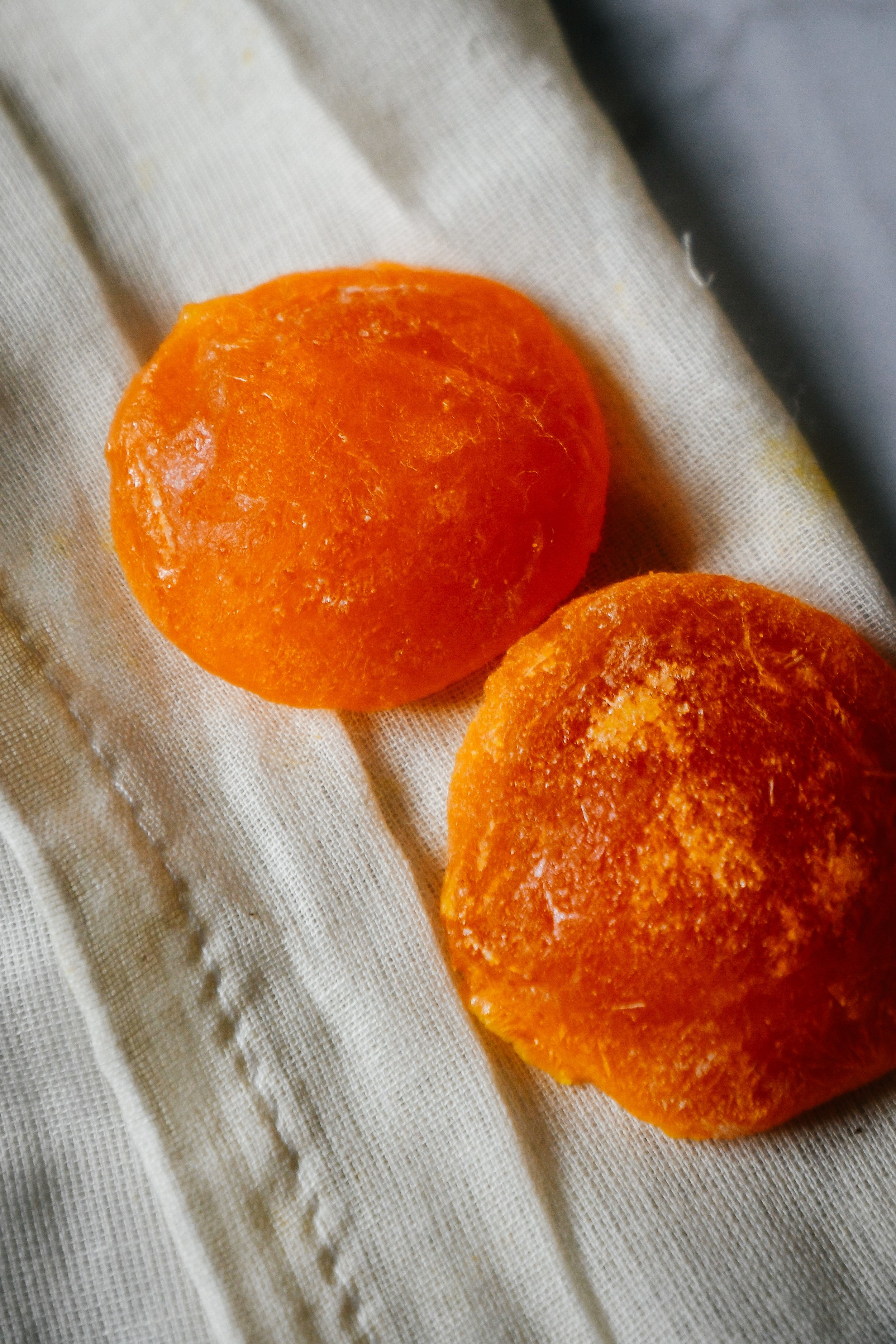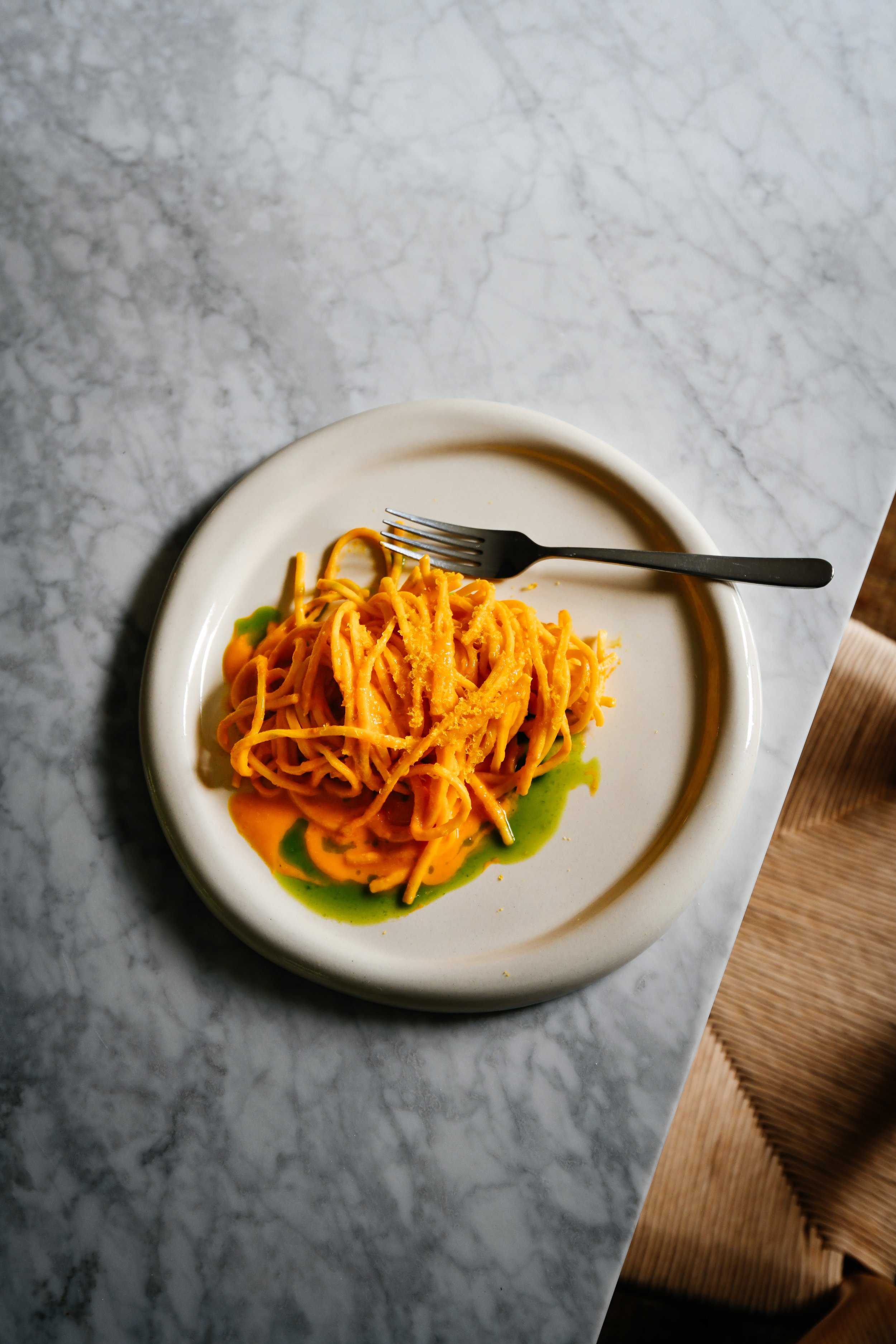Spaghetti alla Chitarra with Yellow Tomato Sugo, Basil Oil and Cured Yolk
Spaghetti alla chitarra is fast becoming one of my favourite pastas to make at home. There is something about the squared edges that draws me to making it again and again. And while I use a special tool called a chitarra (a stringed instrument with tightly wound vertical wires used to cut the pasta), you can achieve a square cut spaghetti using a tagliolini attachment on a regular pasta machine.
Classic tomato basil flavours but a little bit fancy. Yellow tomatoes have a sweet and light flavour to them, that of course pairs wonderfully with classic basil. I love making herb oils for adding a pop of vibrancy and intense flavour in small quantity, and the way the yellow tomato sugo and basil oil contrast together on the plate is a treat for the eyes.
I’m including a recipe for curing egg yolks at home here, although be warned this is a process and takes a couple of weeks. While it is absolutely worth trying, if this isn’t really your thing you can easily just omit from the recipe entirely and go down more of a traditional Parmigiano Reggiano route to finish. Or if you are committed to the fanciness and can find some bottarga at your local monger or specialist deli, it would work wonderfully here.
Spaghetti alla Chitarra with Yellow Tomato Sugo, Basil Oil and Cured Yolk
Serves four
Ingredients
Cured egg yolks
This recipe can be adapted for as many or little yolks as you like, provided you use enough salt to cover them. I would recommend making at least half a dozen at a time given the process is quite lengthy.
6 eggs, yolks separated from the whites (save this whites and use them for other things!)
Fine salt
Tupperware container
Cheesecloth
Pasta dough
360g tipo 00
135g whole eggs
85g egg yolks
Fine semolina (for dusting)
Yellow tomato sugo
EVOO
1 garlic clove, lightly crushed but whole
1 large shallot, diced
500g yellow tomatoes, halved
Basil oil
1 large bunch of basil, roughly 60g
1/4 cup neutral oil, like vegetable or rapeseed oil
1/4 cup mild olive oil
Method
Cured yolks
Pour a layer of salt about 1 inch thick into a Tupperware large enough to contain all of your yolks but not so big that you’ll need kilos of salt to fill it.
Create 6 little grooves in the salt and carefully place a yolk in each one. Cover entirely with salt, again at least half an inch thick.
Cover the Tupperware and place in the fridge for one week.
After a week, carefully dust off the salt and very gently rinse any excess off each yolk and pat dry with kitchen paper. The yolks will be easy to handle but still a bit sticky as they haven’t been dried yet.
Place each yolk along the length of the cheesecloth, then roll the cheesecloth around them to cover. Use kitchen string to tie sections between each yolk and keep the cheesecloth secure and in place.
Dry the fridge in the fridge for another week. The yolks should be dry and firm but not rock solid.
Cured yolks will last 3-4 weeks in the fridge.
Pasta Dough
Place the flour in a mound on your work surface and make a well in the centre.
Add your eggs and begin to whisk to until you have a thick custard-like consistency, incorporating a little bit of flour as you do.
Switch to a bench scraper and start to flip the flour from the outer edge over and onto the egg mix, using a cutting motion to then mix it in. Continue to do this around all sides until you have a shaggy dough.
Begin kneading the dough vigorously for a good 10 minutes until the dough is springy and elastic, and not sticking to your hands at all
Cover and rest for 30 minutes.
Rolling the spaghetti alla chitarra
Divide the dough into four pieces. Work with one at a time - flatten the piece with your hand or a rolling pin before passing it through the thickest setting on your pasta machine. Fold the edges in to create a neat rectangle that fits the width of your pasta machine, and run it through the thickest setting again until your dough is uniform in shape
Continue passing your dough through the machine, working through until you get to setting 4 (on a Marcato machine) - we want the dough relatively thick for this.
Cut the rolled sheet into two halves measuring approx 30cm in length and leave uncovered to dry out while you roll the rest of your sheets.
Place one sheet on top of the wires of a chitarra machine, Lightly dust with fine semolina, then using a rolling pin roll the sheet up and down until the strands of spaghetti are cut by the wires and drop down in the base of the chitarra.
Dust the strands in more fine semolina then roughly shape each sheet into a nest and set aside. Continue with the remaining sheets of dough.
Yellow tomato sugo
Heat 2-3 tablespoons of extra virgin olive oil in a pan. Once hot, drop in the garlic clove and let sizzle until fragrant. you want to infuse the oil with the garlic but not let it burn.
After a few minutes, remove the garlic from the oil, and add the chopped shallot. Sauté gently for 7-10 minutes until soft, translucent and again, not charring or burnt.
Add the yellow tomato halves and a generous pinch of salt, and allow that to cook down for several minutes until the tomatoes start to break down.
Transfer the tomatoes to a blender and whizz until smooth.
Pour the sugo back into a pan and keep warm.
Basil oil
Blanche the basil for a minute or so before transferring to an ice bath.
Once cool, squeeze out as much excess liquid as possible and add to a blender along with the oils.
Blitz until completely smooth and combined - you don’t want to see little bits of leaves in the oil.
Strain through a cheesecloth or fine mesh sieve and discard any of the basil pulp.
Finishing touches
Bring a large pot of water to a rolling boil and salt generously.
Drop in the chitarra nests and cook for 2-3 minutes or until al dente
Using tongs, lift the spaghetti straight out of the water and into the tomato sugo. Toss well to coat each strand.
Divide between bowls, drizzle with basil oil and grate over half a cured yolk per person.





